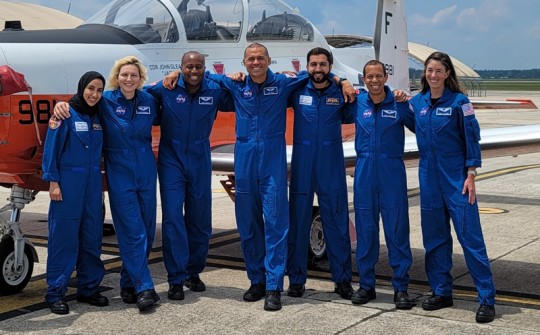Lunar Astronaut Candidates Train at NAS Pensacola
May 24, 2022
Seven NASA astronaut candidates are undergoing flight training at Naval Air Station Pensacola as part of a two-year training pipeline to prepare them for participation in the Artemis lunar exploration program.
The NASA Astronaut Candidate Basic Aviation Curriculum (ASCAN BAC) is administered by Training Air Wing Six (TW-6), which is responsible for the training and production of the Naval Flight Officers (NFOs) who serve as navigators, sensor operators, Weapons System Officers, and Electronic Warfare Officers inside naval aviation.
“ASCAN training is only conducted every three to four years and is very condensed compared to Student Naval Flight Officer training,” said TW-6 Ground Training Officer Mr. John Boman, who oversees the ASCAN training at NAS Pensacola. “ASCANs are in class up to 12 hours per day, or they are scheduled for two flight events per day.”
The ASCAN BAC is designed for candidates without prior military aviation training. It aims to provide students with the knowledge, skills, and abilities required to safely aviate, navigate, and communicate in preparation for follow-on training and responsibilities as NASA flight crew.
“Given the mental aptitude of these individuals, our instructors are able to introduce and practice procedures and skill sets at a quicker pace, which allows us to meet NASA specified training timelines. They have been a pleasure to work with, and knowing that TW-6 helps to put them into space is very rewarding,” said Mr. Boman.
The class includes United States candidates Christina Birch, Andre Douglas, Deniz Burnham, Christopher Williams, and Anil Menon, who were chosen from a field of more than 12,000 applicants, as well as international candidates Nora Al Matrooshi and Mohammad Al Mulla of the United Arab Emirates.
Upon arrival at NAS Pensacola, the ASCANs underwent a one-week Aviation Physiology and Aircrew Water Survival training conducted by the Naval Survival Training Institute. They then began the 10-week ASCAN BAC, which is divided into two stages, familiarization and instrument navigation.
The familiarization stage is comprised of ground school, four simulator events, and five flight events in the T-6A Texan II turboprop trainer aircraft. The instrument navigation stage is comprised of ground school, six simulator events, and six flight events also flown in the T-6A.
Several of the ASCANs are now completing flight events in the instrument navigation stage.
According to police helicopter pilot Mohammad Al Mulla, Navy Aircrew Water Survival Training was a new challenge despite his 15 years of flight experience.
“It was a really good challenge. I felt like after accomplishing Water Survival I’m more comfortable flying, even offshore. I felt really good after passing. I’m really glad to be here and learning from the Navy,” Al Mulla said.
Dr. Anil Menon, who has served as a flight surgeon for NASA, Space X, and the U.S. Air Force, says he is grateful for the quality of training provided by the Navy.
“I did general aviation and I’ve paid for myself to learn how to fly and learn from instructors, but I’ve never encountered instructors as good as the Navy instructors that I’ve worked with. I’ve just learned that there’s a next level to aviation, so it really opened up a lot of doors for me and I’m grateful for those teachers,” Menon said.
In addition to safe operation of a jet aircraft, ASCANs have four major categories of training including operating and maintaining the International Space Station’s systems, preparing for spacewalks, developing complex robotics skills, and Russian language skills.
Deniz Burnham, who serves as a lieutenant in the U.S. Navy Reserves and holds degrees in chemical and mechanical engineering, says as the team nears the end of their training at NAS Pensacola, they look forward to the next challenge.
“We’ll be moving on to the T-38 back in Houston. The T-6 training gave us a good baseline for crew resource management, checklist discipline, procedural recall…this is kind of the foundation to being a value-added team member, and we all look forward to moving on from Pensacola back to Houston,” Burnham said.
The Artemis program aims to put the next man, first woman, and first person of color on the moon in 2024 and to establish a sustainable human presence on the moon by the end of the decade. These accomplishments will in turn prepare humanity for the next step of solar exploration: sending humans to Mars.
story by Ensign Lyndsay Ballew
Pictured: NASA astronaut candidates Christina Birch, Andre Douglas, Deniz Burnham, Christopher Williams, Anil Menon, Nora Al Matrooshi and Mohammad Al Mulla stand beside a T6-A Texan II at Naval Air Station Pensacola. The astronaut candidates began Basic Aviation Curriculum at Training Air Wing Six in late March as part of a two-year training pipeline in preparation for serving the Artemis space exploration program. Photo by Ensign Lyndsay Ballew for NorthEscambia.com, click to enlarge.




Comments